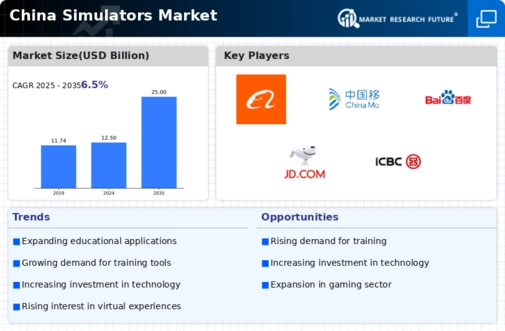Government Initiatives and Funding
Government support plays a crucial role in the expansion of the simulators market in China. Various initiatives aimed at enhancing technological capabilities and workforce training are being implemented. For example, the Chinese government has allocated substantial funding to develop advanced simulation technologies, particularly in defense and education sectors. This funding is expected to reach approximately $500 million by 2026, fostering innovation and encouraging local manufacturers to invest in research and development. Consequently, the simulators market is likely to benefit from increased production capabilities and the introduction of cutting-edge simulation solutions, aligning with national strategic goals.
Rising Popularity of Virtual Reality
The growing popularity of virtual reality (VR) technology is significantly impacting the simulators market in China. VR offers immersive experiences that enhance user engagement and learning outcomes. Industries such as gaming, education, and military training are increasingly adopting VR simulators to provide realistic environments for users. The VR segment of the simulators market is projected to expand at a CAGR of 20% over the next five years, driven by advancements in hardware and software. This trend suggests that the simulators market is on the brink of a technological revolution, with VR poised to redefine training methodologies and user experiences.
Expansion of the Entertainment Sector
The expansion of the entertainment sector in China is contributing to the growth of the simulators market. With the rise of theme parks, gaming centers, and immersive experiences, there is a heightened demand for simulation technologies that can deliver engaging content. The market for entertainment simulators is expected to reach $1 billion by 2027, reflecting a growing consumer appetite for innovative entertainment solutions. This trend indicates that the simulators market is diversifying, as companies seek to capitalize on the lucrative opportunities presented by the entertainment sector, thereby driving further innovation and investment.
Growing Demand for Training Simulators
The rising need for effective training solutions across various sectors is propelling the simulators market in China. Industries such as aviation, military, and healthcare are increasingly adopting simulators to enhance training efficiency and safety. For instance, the aviation sector has witnessed a surge in the use of flight simulators, with the market projected to grow at a CAGR of 10% from 2025 to 2030. This trend indicates a robust demand for high-fidelity training environments, which are essential for skill development and risk mitigation. The simulators market is thus experiencing a significant transformation, driven by the necessity for realistic training experiences that can reduce operational costs and improve performance outcomes.
Integration of Artificial Intelligence
The integration of artificial intelligence (AI) into simulation technologies is revolutionizing the simulators market in China. AI enhances the realism and adaptability of simulations, allowing for more personalized training experiences. This trend is particularly evident in sectors such as healthcare, where AI-driven simulators are being utilized for surgical training and patient care scenarios. The market for AI-based simulators is anticipated to grow by 15% annually, reflecting the increasing reliance on intelligent systems to improve training outcomes. As a result, the simulators market is evolving, with AI becoming a pivotal component in the development of sophisticated training tools.
















Leave a Comment